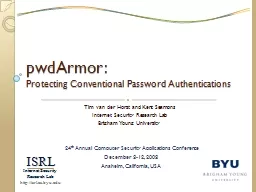PPT-pwdArmor : Protecting Conventional Password Authentications
Author : sherrill-nordquist | Published Date : 2018-10-27
Tim van der Horst and Kent Seamons Internet Security Research Lab Brigham Young University 24 th Annual Computer Security Applications Conference December 812 2008
Presentation Embed Code
Download Presentation
Download Presentation The PPT/PDF document "pwdArmor : Protecting Conventional Pass..." is the property of its rightful owner. Permission is granted to download and print the materials on this website for personal, non-commercial use only, and to display it on your personal computer provided you do not modify the materials and that you retain all copyright notices contained in the materials. By downloading content from our website, you accept the terms of this agreement.
pwdArmor : Protecting Conventional Password Authentications: Transcript
Download Rules Of Document
"pwdArmor : Protecting Conventional Password Authentications"The content belongs to its owner. You may download and print it for personal use, without modification, and keep all copyright notices. By downloading, you agree to these terms.
Related Documents












![[PDF]-Password Organizer: Password Book With Tabs and Alphabetical Password Journal -](https://thumbs.docslides.com/987209/pdf-password-organizer-password-book-with-tabs-and-alphabetical-password-journal-5-x8-over-100-pages-password-log-password-organizer-password-keeper.jpg)